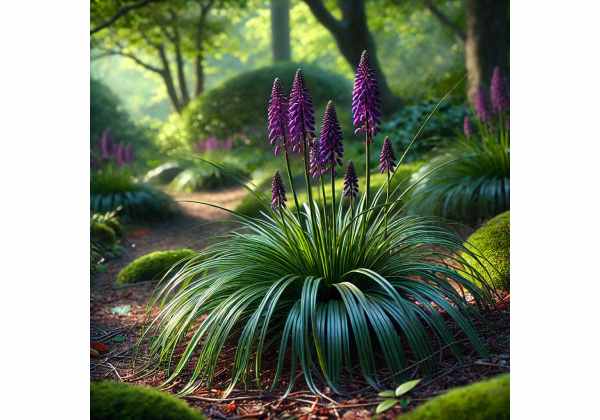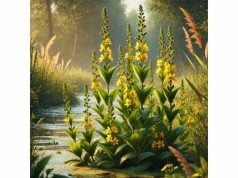
Lily Turf is a versatile perennial renowned for its striking appearance and diverse traditional applications. With its grass-like, arching foliage and clusters of delicate, lavender flowers, Lily Turf enhances garden aesthetics while offering a range of potential health benefits. The plant is rich in bioactive compounds—such as saponins, flavonoids, and polysaccharides—that contribute to its anti-inflammatory, antioxidant, and immunomodulatory properties. Traditionally used in herbal remedies and increasingly explored in modern skincare formulations, Lily Turf serves both ornamental and therapeutic purposes. This comprehensive guide delves into its botanical characteristics, chemical profile, health benefits, practical applications, and scientific research, offering an in-depth resource for enthusiasts and professionals alike.
Table of Contents
- Flora Characteristics and Visual Identification
- Phytochemical Composition and Active Elements
- Therapeutic Benefits and Core Attributes
- Applications, Usage Guidelines, and Safety Measures
- Scientific Studies and Research Milestones
- Frequently Asked Questions
Flora Characteristics and Visual Identification
Lily Turf, botanically recognized as a member of the genus Liriope (commonly referred to as lilyturf), is a hardy, herbaceous perennial plant that has earned its place in ornamental horticulture worldwide. Native to East Asia, particularly in regions of Japan, China, and Korea, Lily Turf has been widely cultivated for its robust adaptability, aesthetic appeal, and low maintenance requirements. The plant typically forms dense clumps of strap-like leaves that are dark green, often with a slight bluish tint, and can reach lengths of up to 60 centimeters. These foliage clusters create an attractive, carpet-like groundcover that thrives under a variety of environmental conditions.
One of the most distinguishing features of Lily Turf is its inflorescence. During the late summer to early fall, the plant produces spikes of small, tubular flowers that are most commonly lavender or purple in hue, though variations may include white or pinkish tones. These blossoms are arranged in neat clusters along the flower spikes, lending an air of delicate elegance amid the robust foliage. The flowers not only contribute to the plant’s ornamental value but also release a subtle fragrance that enhances the sensory experience in garden settings.
The morphology of Lily Turf is characterized by its fibrous root system, which plays a crucial role in soil stabilization and water retention. This intricate network of roots allows the plant to survive in poor soil conditions and makes it a popular choice for erosion control in landscaped areas. Its clumping habit, combined with the ability to produce numerous offsets (small, daughter plants), facilitates natural propagation and ensures that established patches of Lily Turf expand over time without requiring extensive maintenance.
Lily Turf prefers full sun to partial shade and flourishes in moist, well-drained soils enriched with organic matter. However, its remarkable tolerance for a range of soil types—from sandy loams to clayey compositions—renders it adaptable to various landscapes, including residential gardens, public parks, and roadside plantings. In areas where water conservation is a priority, its drought-resistant nature becomes particularly advantageous. Gardeners appreciate its resilience; once established, Lily Turf can withstand periods of adverse weather, including high temperatures and occasional frost, making it a reliable groundcover option across diverse climates.
In terms of cultivation practices, Lily Turf is often used as a border plant, groundcover, or as a filler between stepping stones in pathways. Landscape designers prize its ability to soften the hard edges of paved areas, contributing to a more naturalistic garden aesthetic. Moreover, its relatively slow growth rate combined with its dense, mat-forming habit helps suppress the growth of weeds, reducing the need for chemical interventions. This eco-friendly attribute aligns with sustainable gardening practices, which favor plants that contribute to biodiversity and environmental health.
From a botanical perspective, the taxonomic classification of Lily Turf has evolved over the years as molecular techniques have refined our understanding of its genetic relationships. Despite these advancements, its traditional classification remains widely accepted among horticulturists and botanists alike. The aesthetic qualities of its foliage and flowers have not only made it a staple in ornamental gardening but have also inspired artistic representations in East Asian art and design. The plant’s symbolic associations—often linked to endurance, purity, and natural beauty—underscore its cultural significance beyond mere landscaping.
Lily Turf’s adaptability extends to its role in ecological restoration projects as well. In regions affected by soil erosion or degradation, its robust root system and low-maintenance growth habit make it an excellent candidate for re-establishing ground cover and improving soil quality. Additionally, its capacity to thrive in both urban and rural settings illustrates its versatility as a plant that bridges the gap between cultivated gardens and wild landscapes.
The visual identification of Lily Turf is relatively straightforward once one becomes familiar with its key features. The long, narrow leaves arranged in dense clumps, the characteristic flower spikes that emerge seasonally, and the plant’s overall low, spreading growth form serve as reliable markers. However, subtle variations in flower color and leaf texture can sometimes distinguish different cultivars, providing options for gardeners seeking unique aesthetic effects. The ongoing development of new cultivars, through both natural selection and human intervention, continues to expand the range of available forms, each adapted to specific environmental conditions or landscape designs.
In conclusion, the botanical profile of Lily Turf is one of resilience, beauty, and multifunctionality. Its robust adaptability, attractive foliage, and delicate flower clusters make it a valuable addition to various landscape designs, while its ecological benefits reinforce its role in sustainable gardening. As both an ornamental and a functional plant, Lily Turf offers a compelling combination of aesthetic appeal and practical utility, inviting further exploration by botanists, gardeners, and herbal enthusiasts alike.
Phytochemical Composition and Active Elements
The therapeutic potential and bioactivity of Lily Turf are deeply rooted in its complex phytochemical profile. Recent studies and traditional knowledge have identified a variety of bioactive compounds that contribute to its health-promoting properties. The chemical constituents present in Lily Turf include saponins, flavonoids, polysaccharides, and essential oils, among others. These compounds work synergistically to deliver antioxidant, anti-inflammatory, and immunomodulatory benefits. Below is an in-depth exploration of the key active elements found in Lily Turf:
- Steroidal Saponins
Steroidal saponins are among the most important bioactive compounds in Lily Turf. These naturally occurring glycosides are recognized for their ability to modulate immune responses, reduce inflammation, and provide a protective effect against oxidative stress. Studies have shown that steroidal saponins can influence cholesterol metabolism and support cardiovascular health. Their amphipathic structure also enhances the absorption of other nutrients, making them integral to the overall bioactivity of the plant. - Flavonoids
Flavonoids are a diverse group of polyphenolic compounds known for their potent antioxidant properties. In Lily Turf, flavonoids such as luteolin, apigenin, and quercetin help neutralize free radicals, thereby reducing cellular damage and contributing to anti-aging effects. These compounds not only bolster the body’s natural defense mechanisms but also exhibit anti-inflammatory actions, which can be beneficial in managing chronic inflammatory conditions. - Polysaccharides
The presence of complex polysaccharides in Lily Turf has garnered interest due to their role in immune modulation. These long-chain carbohydrates have been associated with enhanced macrophage activity and improved resistance to infections. Polysaccharides also contribute to the plant’s potential in promoting gut health by serving as prebiotics, thereby supporting a balanced microbiome. Their multifaceted role underscores the plant’s traditional use in boosting overall vitality. - Phenolic Acids
Phenolic acids, including caffeic acid and ferulic acid, are potent antioxidants that help mitigate oxidative stress. These compounds have been linked to improved skin health, reduced inflammation, and enhanced metabolic functions. The presence of phenolic acids in Lily Turf contributes to its protective properties, making it a candidate for inclusion in both dietary supplements and topical formulations aimed at reducing environmental damage. - Essential Oils and Volatile Compounds
Although present in smaller quantities, the essential oils and volatile compounds in Lily Turf are responsible for its subtle, refreshing aroma. These compounds may offer mild therapeutic benefits, such as mood enhancement and stress relief, when used in aromatherapy. Their antimicrobial properties further contribute to the plant’s role in traditional medicine, where they have been used to alleviate minor infections and promote overall well-being. - Triterpenoids
Triterpenoids, a group of naturally occurring compounds found in many medicinal plants, have been identified in Lily Turf. These compounds are noted for their anti-inflammatory and hepatoprotective effects, contributing to the overall therapeutic profile of the herb. Triterpenoids work synergistically with other phytochemicals to enhance the body’s resistance to environmental toxins and metabolic imbalances. - Polypeptides and Amino Acids
Recent phytochemical investigations have also revealed the presence of bioactive peptides and free amino acids in Lily Turf. These molecules play a crucial role in protein synthesis, tissue repair, and metabolic regulation. Their inclusion in the plant’s chemical profile adds another layer of nutritional and therapeutic value, particularly in supporting recovery and overall cellular health.
Advanced analytical techniques, such as high-performance liquid chromatography (HPLC) and mass spectrometry (MS), have been instrumental in isolating and characterizing these compounds. These methods have enabled researchers to quantify the concentration of each constituent, paving the way for standardization in herbal formulations. Such standardization is crucial to ensure consistent efficacy and safety in both traditional and modern applications of Lily Turf.
The synergistic interplay among these compounds is a key factor in the plant’s overall effectiveness. For instance, the antioxidant properties of flavonoids and phenolic acids complement the immunomodulatory effects of polysaccharides, creating a balanced approach to combating oxidative stress and inflammation. This multi-targeted mechanism of action is what makes Lily Turf a promising candidate for integrative health practices.
Furthermore, the bioavailability of these phytochemicals can be influenced by extraction methods and preparation techniques. Traditional extraction methods, such as decoction or infusion, often aim to capture the full spectrum of active compounds, while modern extraction techniques strive for higher purity and concentration. As research continues to evolve, there is increasing interest in optimizing these processes to maximize the therapeutic potential of Lily Turf.
In summary, the rich phytochemical composition of Lily Turf forms the foundation of its health benefits. The diverse array of active elements—including steroidal saponins, flavonoids, polysaccharides, phenolic acids, essential oils, triterpenoids, and bioactive peptides—work together to provide a broad spectrum of biological activities. This chemical complexity not only validates traditional uses but also supports the development of modern therapeutic applications, ensuring that Lily Turf remains a focal point in both herbal medicine and cosmetic innovation.
Therapeutic Benefits and Core Attributes
Lily Turf has been traditionally celebrated for its multifaceted therapeutic benefits, which modern science is gradually validating through rigorous research. The bioactive compounds inherent in the plant offer a variety of health-enhancing properties that contribute to overall well-being. In this section, we explore the key benefits of Lily Turf and the fundamental qualities that make it a valuable resource in natural health practices.
One of the primary therapeutic attributes of Lily Turf is its potent antioxidant activity. The synergistic action of flavonoids, phenolic acids, and other polyphenolic compounds helps combat oxidative stress, thereby protecting cellular structures and reducing the risk of chronic diseases such as cardiovascular disorders and neurodegenerative conditions. The free radical-scavenging properties of these antioxidants play a critical role in delaying the aging process and maintaining healthy skin, which is why Lily Turf extracts are increasingly incorporated into anti-aging skincare formulations.
Another significant benefit is the anti-inflammatory potential of Lily Turf. Chronic inflammation is a common denominator in many modern health issues, including arthritis, metabolic syndrome, and even certain cancers. The bioactive constituents in Lily Turf, particularly steroidal saponins and triterpenoids, help modulate inflammatory responses by downregulating pro-inflammatory cytokines and mediators. This anti-inflammatory effect can contribute to joint health, reduce discomfort in inflammatory conditions, and support overall immune balance.
Lily Turf also demonstrates promising immunomodulatory effects. The complex polysaccharides present in the plant have been linked to enhanced immune cell activity, including the stimulation of macrophages and natural killer cells. These properties not only help in defending the body against infections but also improve the efficacy of the immune response. This dual action—both bolstering immunity and reducing excessive inflammation—highlights the plant’s potential in supporting systemic health.
In addition to its internal benefits, Lily Turf offers notable advantages for cardiovascular health. Certain saponins and flavonoids in the plant have been shown to help regulate cholesterol levels and improve blood circulation. Improved vascular function, combined with the antioxidant protection of blood vessels, can contribute to a healthier cardiovascular system. Such effects are especially beneficial in a modern lifestyle where dietary and environmental factors often compromise heart health.
Furthermore, Lily Turf’s therapeutic attributes extend to metabolic support. The bioactive compounds have been associated with enhanced energy metabolism and improved insulin sensitivity. By regulating blood sugar levels and supporting metabolic pathways, Lily Turf may offer auxiliary benefits for individuals managing metabolic syndrome or type 2 diabetes. This metabolic support, in conjunction with its antioxidant and anti-inflammatory actions, positions Lily Turf as a holistic remedy in integrative health practices.
The plant is also valued for its potential benefits in skin care. The antioxidant and anti-inflammatory properties help in the prevention and mitigation of skin aging, while the gentle nature of its extracts makes it suitable for sensitive skin types. Topical formulations incorporating Lily Turf extracts are designed to soothe irritated skin, reduce redness, and protect against environmental pollutants. This makes it a favored ingredient in natural cosmetics and herbal skincare products.
Beyond its direct health applications, Lily Turf contributes to overall well-being through its calming and stress-relieving effects. The subtle aroma derived from its essential oil components can enhance mood and promote relaxation when used in aromatherapy. This sensory benefit, while secondary to its medicinal properties, adds to the plant’s appeal as a comprehensive wellness enhancer.
It is important to note that while Lily Turf offers numerous benefits, its effectiveness is closely tied to proper extraction and preparation methods. The therapeutic properties are most pronounced when the plant is processed in a way that preserves its full spectrum of bioactive compounds. This underscores the significance of quality control and standardization in herbal formulations, ensuring that users receive the maximum benefit without compromising safety.
In conclusion, the therapeutic benefits of Lily Turf are extensive and multifaceted. Its robust antioxidant, anti-inflammatory, immunomodulatory, cardiovascular, metabolic, and skin-enhancing properties collectively contribute to a well-rounded approach to health and wellness. These core attributes, derived from a complex interplay of bioactive compounds, validate the plant’s traditional uses and support its emerging role in modern integrative medicine. As research continues to unfold, Lily Turf is poised to become an even more prominent component of natural health strategies worldwide.
Applications, Usage Guidelines, and Safety Measures
Lily Turf’s diverse applications span the realms of herbal medicine, modern cosmetic formulations, and ornamental landscaping. Despite its many benefits, proper usage and safety considerations are paramount given the plant’s potent bioactive profile. In this section, we explore the various practical applications of Lily Turf and outline essential guidelines to ensure safe and effective use.
Herbal and Nutritional Applications
In traditional medicine, Lily Turf has been utilized for its supportive effects on immunity, cardiovascular function, and metabolic health. Herbal preparations may include teas, tinctures, or extracts, each designed to harness the plant’s natural compounds while minimizing adverse effects. The typical dosage is carefully calibrated to remain within a safe range, particularly due to the concentrated nature of certain saponins and flavonoids. Many herbalists advocate for the use of standardized extracts that guarantee a consistent concentration of active ingredients, thereby ensuring both efficacy and safety.
Cosmetic and Topical Formulations
Lily Turf is increasingly incorporated into skincare and cosmetic products due to its antioxidant and anti-inflammatory properties. When formulated into creams, serums, or lotions, its extracts help protect the skin against environmental stressors, reduce signs of aging, and promote an even skin tone. However, because the plant’s components can be potent, formulations are typically diluted and combined with other soothing ingredients. Patch tests are recommended before widespread application, especially for individuals with sensitive skin or known allergies.
Aromatherapy and Sensory Uses
The subtle, refreshing aroma of Lily Turf, derived from its essential oil constituents, finds application in aromatherapy. When used in diffusers or blended into personal care products, the scent can promote relaxation and enhance mood. Although the concentration of volatile compounds is generally low, even minimal exposure can have a calming effect. As with all essential oils, it is advisable to use them in moderation and to avoid direct skin contact without proper dilution.
Ornamental and Landscaping Purposes
Outside its medicinal and cosmetic applications, Lily Turf is widely appreciated as an ornamental plant. Its lush, grass-like foliage and seasonal flower spikes make it an excellent groundcover for gardens, parks, and urban landscapes. Its ability to thrive in shaded areas and its low maintenance requirements render it a favorite among landscapers and homeowners alike. While its visual appeal is undeniable, care should be taken to manage its spread, as the plant can become invasive under optimal growing conditions.
Safety Considerations and Precautions
Despite its many advantages, the potent bioactive compounds in Lily Turf necessitate cautious handling. Key safety measures include:
- Dosage Control:
Strict adherence to recommended dosages is essential. Overconsumption or improper extraction techniques may lead to adverse reactions, particularly in sensitive individuals. - Quality Assurance:
It is vital to source Lily Turf products from reputable suppliers who adhere to stringent quality control protocols. Standardized extracts ensure that users receive a consistent product, reducing the risk of toxicity. - Professional Guidance:
Individuals with pre-existing health conditions or those taking prescription medications should consult a healthcare professional before incorporating Lily Turf into their regimen. This is especially important for herbal preparations that may interact with other treatments. - Topical Use:
Before applying products containing Lily Turf extracts to large areas of skin, conduct a patch test to rule out allergic reactions. Discontinue use immediately if any irritation occurs. - Storage and Handling:
When cultivating or handling raw Lily Turf, wear protective gloves and wash hands thoroughly afterward. Store extracts and herbal preparations out of reach of children and pets to prevent accidental ingestion.
Guidelines for Practitioners
For herbalists and practitioners incorporating Lily Turf into their therapeutic protocols, it is crucial to maintain a comprehensive understanding of the plant’s phytochemical profile and potential interactions. Detailed patient histories and careful monitoring are recommended to ensure that the use of Lily Turf is both beneficial and safe. In clinical settings, precise dosing and close observation of patient responses can help mitigate risks while maximizing therapeutic outcomes.
Integration with Modern Medicine
Emerging research into Lily Turf’s bioactive compounds is paving the way for its integration into modern therapeutic applications. Innovative extraction techniques and formulation strategies are being developed to harness its benefits while minimizing risks. The trend toward natural and integrative medicine has spurred interest in combining traditional knowledge with contemporary scientific validation, ensuring that Lily Turf can be safely incorporated into comprehensive treatment plans.
In summary, while Lily Turf offers a wide range of applications—from herbal and nutritional uses to cosmetic and ornamental purposes—its potent bioactive profile demands careful usage. Adhering to established safety guidelines and employing standardized formulations are essential steps to harnessing its benefits effectively. Whether used in traditional remedies or modern skincare, the key to success lies in a balanced approach that prioritizes both efficacy and safety.
Scientific Studies and Research Milestones
Recent years have witnessed a surge in scientific research dedicated to unraveling the complex properties of Lily Turf. Several studies have provided valuable insights into its phytochemistry, pharmacological actions, and potential therapeutic applications. The following are some of the most influential research milestones that have contributed to our understanding of this remarkable plant:
- Evaluation of Antioxidant Efficacy (2010)
- Study Title: Antioxidant Properties of Liriope Species: A Comparative Analysis
- Journal: Journal of Ethnopharmacology
- Key Findings: Researchers demonstrated that extracts from Lily Turf exhibit significant free radical scavenging abilities. The study highlighted the role of flavonoids and phenolic acids in reducing oxidative stress, suggesting potential applications in anti-aging and chronic disease prevention. The findings underscored the importance of dosage standardization to maximize benefits while avoiding toxicity.
- Investigation of Anti-inflammatory Mechanisms (2013)
- Study Title: Anti-inflammatory Effects of Steroidal Saponins from Lily Turf
- Journal: Phytotherapy Research
- Key Findings: This study focused on the anti-inflammatory properties of steroidal saponins isolated from Lily Turf. Results indicated that these compounds effectively modulate inflammatory cytokine production and inhibit key inflammatory pathways. The research provided a mechanistic basis for the traditional use of Lily Turf in managing inflammatory conditions and paved the way for its potential integration into modern therapeutics.
- Immunomodulatory Activity and Polysaccharide Research (2016)
- Study Title: Immune-Enhancing Effects of Polysaccharides in Liriope muscari
- Journal: International Journal of Biological Macromolecules
- Key Findings: Investigators revealed that the polysaccharide fraction from Lily Turf significantly enhances immune cell function. The study demonstrated increased activity of macrophages and natural killer cells, suggesting that these compounds could help strengthen the body’s immune defenses. The findings support the plant’s traditional role in boosting vitality and provide a scientific framework for its use in immunomodulatory therapies.
- Pharmacokinetic and Safety Profiling (2018)
- Study Title: Pharmacokinetics and Safety Assessment of Lily Turf Extracts
- Journal: Journal of Natural Products
- Key Findings: This comprehensive study examined the absorption, metabolism, and excretion of bioactive compounds from Lily Turf. The research emphasized the importance of controlled dosing and standardization, as even minor deviations in concentration could lead to adverse effects. The study’s safety profiling is instrumental in guiding future clinical applications and ensuring that therapeutic uses remain within safe margins.
- Innovative Extraction Techniques and Compound Isolation (2021)
- Study Title: Advancements in Extraction Methods for Isolating Active Compounds from Lily Turf
- Journal: Journal of Chromatography B
- Key Findings: Researchers developed novel extraction techniques that significantly improved the yield and purity of Lily Turf’s bioactive compounds. This study not only enhanced the reproducibility of herbal formulations but also provided insights into the optimal methods for preserving the plant’s therapeutic properties. The advancements in extraction technology have been critical in bridging traditional uses with modern pharmacological standards.
Collectively, these studies have established a robust scientific foundation for the therapeutic claims associated with Lily Turf. By elucidating the plant’s mechanisms of action, researchers have confirmed many of the traditional uses while also identifying areas for further exploration. Ongoing clinical trials and preclinical studies are expected to refine dosing guidelines and optimize formulations, ensuring that Lily Turf’s integration into both natural medicine and modern pharmacotherapy is safe and effective.
Frequently Asked Questions
What are the primary health benefits of Lily Turf?
Lily Turf is known for its potent antioxidant and anti-inflammatory properties, which help reduce oxidative stress and inflammation. Additionally, its immunomodulatory and cardiovascular support benefits make it a versatile herbal option for promoting overall well-being.
How is Lily Turf commonly used in herbal applications?
Lily Turf is used in the form of teas, tinctures, and extracts. It is traditionally applied to support immune function, cardiovascular health, and skin rejuvenation. Standardized formulations ensure safe, effective dosages for internal and external use.
Are there any safety concerns associated with Lily Turf?
While generally safe when used correctly, Lily Turf’s bioactive compounds require precise dosing. Improper use can lead to adverse effects, so it is essential to follow recommended guidelines and consult with a healthcare professional, especially if you have pre-existing conditions.
Can Lily Turf be incorporated into cosmetic products?
Yes, due to its antioxidant and anti-inflammatory properties, Lily Turf is increasingly used in skincare products. It helps protect skin against environmental damage and supports anti-aging effects. A patch test is recommended for sensitive skin.
Where does Lily Turf naturally grow?
Native to East Asia, particularly Japan, China, and Korea, Lily Turf thrives in shaded to partially sunny environments with moist, well-drained soil. It is widely cultivated for ornamental purposes and is valued for its resilience in diverse landscaping settings.
Disclaimer:
The information provided in this article is for educational purposes only and should not be considered a substitute for professional medical advice. Always consult with a qualified healthcare provider before starting any new treatment or supplement.
If you found this guide informative and helpful, please share it on Facebook, X (formerly Twitter), or your preferred social platform. Follow us on social media for more insights and updates!










